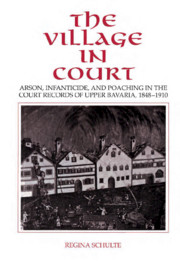 The Village in Court
The Village in Court Book contents
3 - The Bridal Wagon
from PART II - THE STATUS OF WOMEN AND THE PLACE OF CHILDREN
Published online by Cambridge University Press: 04 May 2010
Summary
But when we arrived at the form, there stood a huge open-frame wagon, decked out with ribbons, greenery, and garlands, adorned with jugs and pictures, and laden with the household goods of the future Mrs. Lackenschuster. Pride of place in the center was taken by the four-poster bed, with its well-filled down pillows and bedspreads in front of it, the cradle was prominently displayed, and on it the richly carved house-altar. Behind all this stood the wardrobe, doors wide open, boasting all sorts of silk petticoats and fashionable gowns, heavy bales of linen bound with braided linen thread interlaced with ribbons, silk shawls, splendid prayer books, and cleverly wrought wax tapers. From the wardrobe doors hung rosaries, scapulars, and a profusion of holy pictures.…
The wagon was drawn by six oxen, Sonnenreuth's seamstress allowed herself to be lifted up to the spinning wheel, the cow of the late Mrs. Irscher came trotting out of the cow shed, adorned with garlands and bunches of flowers, led by the local carpenter.
…As the wagon left Watzling for Pellham it was an impressive sight to behold, and everybody said that Reischl's prospective wife had put together a splendid dowry.
The procession of the bridal wagon (Kammerwagen or Kuchelwagen) through the village, accompanied by musicians, is a spectacle and a statement. The bridal wagon's journey from the bride's house to the bridegroom's a few days before the church ceremony not only marks the beginning of a great feast, a peasant wedding, which was celebrated on a grand scale by the bridal couple, their families and kin, the servants of the farms involved, and by the village.
- Type
- Chapter
- Information
- The Village in CourtArson, Infanticide, and Poaching in the Court Records of Upper Bavaria 1848–1910, pp. 79 - 82Publisher: Cambridge University PressPrint publication year: 1994


